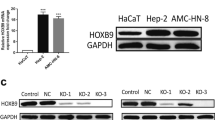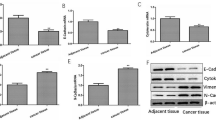Abstract
Background
The present study is to investigate the biological functions and mechanisms of circular RNA_0000523 (circ_0000523) in nasopharyngeal carcinoma (NPC).
Methods
Quantitative reverse transcription-polymerase chain reaction (qRT-PCR) was conducted to examine the expression levels of circ_0000523 and microRNA-1184 (miR-1184) in NPC tissues and cells. Collagen type 1 alpha 1 chain (COL1A1) expression was assessed by qRT-PCR and immunohistochemistry (IHC) assay. Cell proliferation, cell cycle progression, migration and invasion were examined by cell counting kit-8 (CCK-8), 5-bromo-2’-deoxyuridine (BrdU), flow cytometry and Transwell assays. Xenograft nude mouse models were used to investigate the metastatic potential of NPC cells in vivo. The binding relationships between circ_0000523 and miR-1184, and between miR-1184 and COL1A1 were detected by dual-luciferase reporter gene assay. The protein expressions of COL1A1, phosphatidylinositol 3-kinase (p85), phosphorylated (p)-p85, protein kinase B (Akt) and p-Akt were detected through Western blot. The DAVID database was used for the enrichment analysis of the potential targets of miR-1184.
Results
Circ_0000523 and COL1A1 mRNA expressions were significantly increased in NPC tissues and cell lines. Circ_0000523 overexpression promoted NPC cell proliferation and accelerated cell cycle progression, whereas miR-1184 overexpression reversed these effects; circ_0000523 knockdown suppressed NPC cell proliferation and induced cell cycle arrest, while miR-1184 inhibition counteracted these effects. MiR-1184 was the downstream target of circ_0000523, and COL1A1 was the target gene of miR-1184 and could be positively modulated by circ_0000523. COL1A1 overexpression increased the expression levels of p-p85 and p-Akt, whereas knocking down COL1A1 repressed their expressions.
Conclusions
Circ_0000523 facilitates NPC progression through regulating the miR-1184/COL1A1 axis.






Similar content being viewed by others
References
Le QT et al (2019) Current Treatment Landscape of Nasopharyngeal Carcinoma and Potential Trials Evaluating the Value of Immunotherapy. J Natl Cancer Inst 111(7):655–663
Sun XS et al (2019) Future of Radiotherapy in Nasopharyngeal Carcinoma. Br J Radiol 92(1102):20190209
Zhang W et al (2019) NKILA represses nasopharyngeal carcinoma carcinogenesis and metastasis by NF-κB pathway inhibition. PLoS Genet 15(8):e1008325
Ni M et al (2021) Induction Chemotherapy Combined With Intensity-Modulated Radiotherapy for 129 Nasopharyngeal Carcinoma Patients With Synchronous Metastases: A Retrospective Study. Front Oncol 11:654871
Huang A et al (2020) Circular RNA-protein interactions: functions, mechanisms, and identification. Theranostics 10(8):3503–3517
Kristensen LS et al (2018) Circular RNAs in cancer: opportunities and challenges in the field. Oncogene 37(5):555–565
Yang M, Huang W (2020) Circular RNAs in nasopharyngeal carcinoma. Clin Chim Acta 508:240–248
Shuai M, Huang L (2020) High Expression of hsa_circRNA_001387 in Nasopharyngeal Carcinoma and the Effect on Efficacy of Radiotherapy. Onco Targets Ther 13:3965–3973
Zhu L et al (2019) CircRNA ZNF609 promotes growth and metastasis of nasopharyngeal carcinoma by competing with microRNA-150-5p. Eur Rev Med Pharmacol Sci 23(7):2817–2826
Wang CX et al (2018) METTL3-mediated m6A modification is required for cerebellar development. PLoS Biol 16(6):e2004880
Meng QZ et al (2020) METTL3 promotes the progression of nasopharyngeal carcinoma through mediating M6A modification of EZH2. Eur Rev Med Pharmacol Sci 24(8):4328–4336
Liang TS et al (2019) MicroRNA-506 inhibits tumor growth and metastasis in nasopharyngeal carcinoma through the inactivation of the Wnt/β-catenin signaling pathway by down-regulating LHX2. J Exp Clin Cancer Res 38(1):97
Yang D et al (2020) Silencing circular RNA VANGL1 inhibits progression of bladder cancer by regulating miR-1184/IGFBP2 axis. Cancer Med 9(2):700–710
Yan R et al (2022) Therapeutic targeting m6A-guided miR-146a-5p signaling contributes to the melittin-induced selective suppression of bladder cancer.Cancer letters, : p.215615
Huang K-B et al (2021) Circular RNA circSNX6 promotes sunitinib resistance in renal cell carcinoma through the miR-1184/GPCPD1/ lysophosphatidic acid axis. Cancer Lett 523:121–134
Dietrichs D et al (2022) Three-Dimensional Growth of Prostate Cancer Cells Exposed to Simulated Microgravity. Front cell Dev biology 10:841017
Tirrò E et al (2022) Next generation sequencing in a cohort of patients with rare sarcoma histotypes: A single institution experience. Pathol Res Pract 232:153820
Guo Y et al (2019) Improved Radiotherapy Sensitivity of Nasopharyngeal Carcinoma Cells by miR-29-3p Targeting COL1A1 3’-UTR. Med Sci Monit 25:3161–3169
Chen YP et al (2019) Nasopharyngeal carcinoma. Lancet 394(10192):64–80
Duan B et al (2019) Exosomal miR-17-5p promotes angiogenesis in nasopharyngeal carcinoma via targeting BAMBI. J Cancer 10(26):6681–6692
Anastasiadou E, Jacob LS, Slack FJ (2018) Non-coding RNA networks in cancer. Nat Rev Cancer 18(1):5–18
Zhang HD et al (2018) CircRNA: a novel type of biomarker for cancer. Breast Cancer 25(1):1–7
Li S, Wang Q (2020) Hsa_circ_0081534 increases the proliferation and invasion of nasopharyngeal carcinoma cells through regulating the miR-508-5p/FN1 axis. Aging 12(20):20645–20657
Wei H et al (2019) Circular RNA circ_0008450 upregulates CXCL9 expression by targeting miR-577 to regulate cell proliferation and invasion in nasopharyngeal carcinoma. Exp Mol Pathol 110:104288
Jin Y et al (2018) Circular RNA hsa_circ_0000523 regulates the proliferation and apoptosis of colorectal cancer cells as miRNA sponge. Brazilian J Med Biol research = Revista brasileira de pesquisas medicas e biologicas 51(12):e7811
Correia de Sousa M et al (2019) Deciphering miRNAs’ Action through miRNA Editing.Int J Mol Sci, 20(24)
Jiang P et al (2020) Interference with circBC048201 inhibits the proliferation, migration, and invasion of bladder cancer cells through the miR-1184/ITGA3 axis. Mol Cell Biochem 474(1–2):83–94
Chen S et al (2020) miR-1184 regulates the proliferation and apoptosis of colon cancer cells via targeting CSNK2A1. Mol Cell Probes 53:101625
Wang X et al (2020) Hsa_circ_0128846 promotes tumorigenesis of colorectal cancer by sponging hsa-miR-1184 and releasing AJUBA and inactivating Hippo/YAP signalling. J Cell Mol Med 24(17):9908–9924
An Q et al (2020) circKRT7-miR-29a-3p-COL1A1 Axis Promotes Ovarian Cancer Cell Progression. Onco Targets Ther 13:8963–8976
Liu J et al (2018) Collagen 1A1 (COL1A1) promotes metastasis of breast cancer and is a potential therapeutic target. Discov Med 25(139):211–223
Lin P et al (2020) Clinical significance of COL1A1 and COL1A2 expression levels in hypopharyngeal squamous cell carcinoma. Oncol Lett 20(1):803–809
Ma HP et al (2019) Collagen 1A1 (COL1A1) Is a Reliable Biomarker and Putative Therapeutic Target for Hepatocellular Carcinogenesis and Metastasis.Cancers (Basel), 11(6)
Guo Y et al (2020) miR-133b Suppresses Invasion and Migration of Gastric Cancer Cells via the COL1A1/TGF-β Axis. Onco Targets Ther 13:7985–7995
Guo Y et al (2019) Improved Radiotherapy Sensitivity of Nasopharyngeal Carcinoma Cells by miR-29-3p Targeting COL1A1 3’-UTR. Medical science monitor: international medical journal of experimental and clinical research, 25: p. 3161–3169
Author information
Authors and Affiliations
Corresponding author
Additional information
Publisher’s Note
Springer Nature remains neutral with regard to jurisdictional claims in published maps and institutional affiliations.
Electronic supplementary material
Below is the link to the electronic supplementary material.
Rights and permissions
About this article
Cite this article
Huang, P., Li, M., Tang, Q. et al. Circ_0000523 regulates miR-1184/COL1A1/PI3K/Akt pathway to promote nasopharyngeal carcinoma progression. Apoptosis 27, 751–761 (2022). https://doi.org/10.1007/s10495-022-01743-y
Accepted:
Published:
Issue Date:
DOI: https://doi.org/10.1007/s10495-022-01743-y




